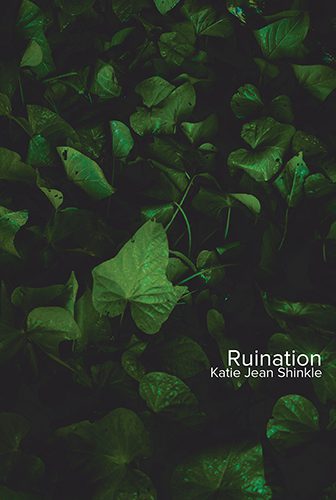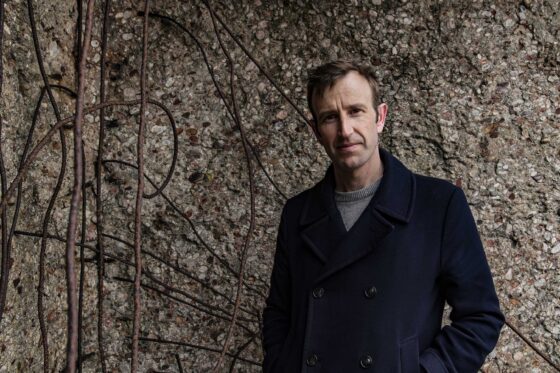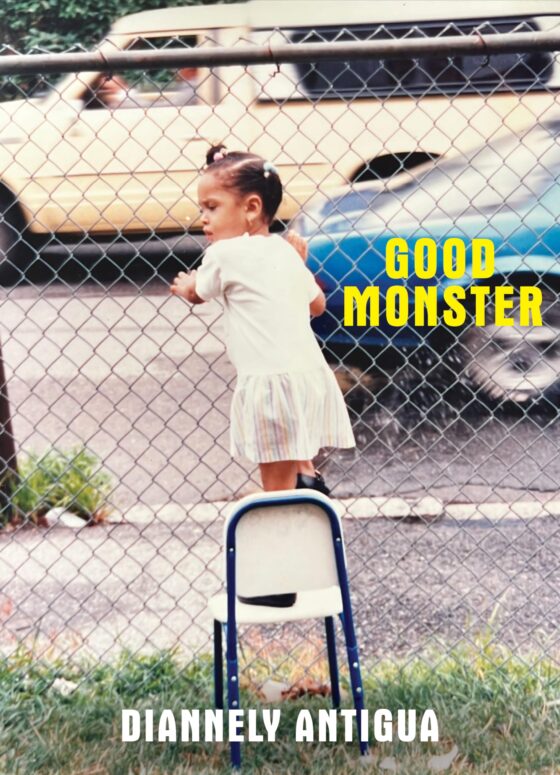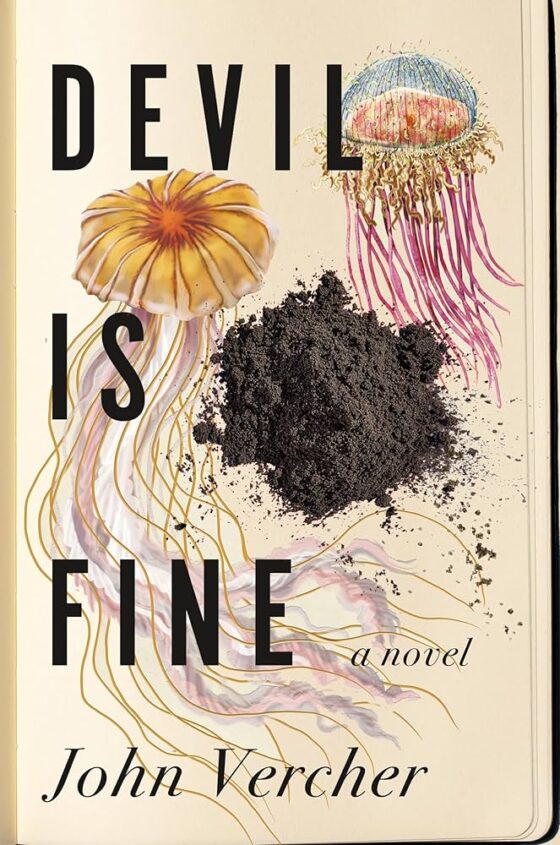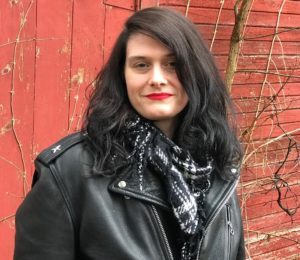
Ruination opens with two girls sitting on a mattress in the front yard making out during a super storm. A nuclear bomb has been detonated, but no clear enemy is ever defined, just a mysterious “other.” All the mothers are sent to war. The men stay home with their daughters. Like fog, details of the situation slowly come into view.
“All The Men are desperate,” Katie Jean Shinkle writes. “They need faith and hope.” It is a harrowing beginning to a powerful, yet brief look at the corrupting nature of power. In the aftermath of the event, plant life surges through the bodies of the remaining girls—it grows through their bodies, takes them, uncontrollably. Then, the Center for Eradication comes and begins to take the girls away, out of fear, out of their desire to study them: “All females exhibiting any evidence of vegetation on their person or in their household should be reported immediately.” A tendril of love runs through the book between our narrator and her crush, the girl she made out on the mattress with and slowly, the crush opens to her, but perhaps not in the way she wants.
That feeling of longing during my own teenage years was similarly painful and confusing. Ruination brought a lot of this up for me — how society controls us, how we turn that control on ourselves and each other. The book is fragmented and glitters the way rain might sit on grass after a night time storm. The text is loamy and I read it in less than a day. Shinkle’s last book, The Arson People (CCM Press, 2015) similarly takes place in a small town, and is also a bright and dangerous testament to rural, young, queer life.
We spoke about adolescence, why rural Revival culture can be dangerous, and how place is as much a character in narrative as any person.
***
The Rumpus: Where did the idea of Ruination first come from?
Katie Jean Shinkle: Between 2013–2015, I had been researching three very different sets of information: hostage situation protocol (domestic, such as terrorism and cults), nuclear weapon reaction procedures (war, bombs), and flowers (mostly floral guides, botanical names, how and where things grow). I had no formal plan for this research. In late 2015, over the course of ten days, I wrote Ruination in its entirety. The book is the amalgamation of all the research done between 2013–2015. The writing began with the image of a protea pushing itself through skin, though that specific vignette got cut from the book eventually. I couldn’t get the large spindles of the protea out of my head and how those spindles might erupt from the body, and the rest of the book followed.
Rumpus: What I love most about this book is that a) the only life that returns is the life that comes through the girls and b) that plant life is so powerful it is devastating. It is as if nature is trying to reclaim what is most powerful about itself. If historically women are doorways between the last world and this one, if women sit as the zero integer between all others, it makes sense to me then that they would then become, in Ruination, the doorway between the last world (The World of Men) and the next to come. I am curious about what draws you to the specific types of vegetation you chose most— mostly angiosperms. Did the flowers choose each girl based on the girls’ unique personalities? Do the flowers themselves have personalities that picked each girl?
Shinkle: I read this question as more to do with place. The place, for me, and not the actual vegetation, is what holds the consciousness and agency in this book. I believe faithfully in the direct consciousness of place, that a place is in itself is as much of a “character” as the people that occupy a narrative. In my books, and in my life, this is definitely the case. In Ruination, the weather-ravaged small Midwestern town, as well as the weather, holds its own consciousness, and is in control of the shifts and changes taking place post-devastation. It was not my intention, however, to have the vegetation, specifically, have the agency to choose the people it overtakes or even to establish a relationship between which character is effected/affected by what kinds of vegetation. I guess the answer here is no, the vegetation didn’t choose each girl and the flowers/vegetation themselves do not have unique personalities that target people. I do like this idea, though, and an argument could certainly be made that this is the case, even if it wasn’t my intention, and I can’t exactly draw that conclusion or make the connections because I am too close to the text.
Rumpus: I find myself obsessed with plants and almost have so many that I can’t take care of all them. Is your relationship with plants similar?
Shinkle: While I love nature in varying degrees (especially large bodies of water/beach culture), and I like the idea of gardens and tending to houseplants, it is just not my thing. In my family mythology, the story is that my grandmother (my mother’s mother) is said to have killed, much to her dismay, every plant/flower she tried to tend to, and my mother is the exact opposite—she is, in fact, an Advanced Master Gardener. My whole life my mother always had a house full of green plants that thrived, and yards full of gardens that she worked tirelessly in to make beautiful. I do believe this gift of tending to plants skipped me, that I am my grandmother’s twin in this way. I even accidentally, and sadly, killed a small cactus once, which drooped over and bled (!!!) all over my checkbooks. I overwatered it—and I barely watered it—so that was at once a huge surprise and also a sign that I do not have a green thumb, that my thumb, in fact, is black.
Rumpus: It’s a common theme to associate flowers with femininity. I grew up with the cultural connotation of Georgia O’Keefe’s work, for example, being all about female genitalia. I went to an exhibit at the art museum near me recently to see her work in person, up close, and was surprised to learn that she denied the connotations of that throughout her career, though many art scholars have studied and speculated as to whether or not this is true. I think of a few lines from Ruination about Paula, the narrator’s love interest:
Paula doesn’t want anyone to see where her genitals should be is a heliotropic sunflower, losing seeds from the face.
I am staying the night with Paula and she says I want you to see. She lifts the bottom of her nightgown to reveal knotty, splintered wood. Flakes of her skin like rind, ribbed and curled. Her thighs covered with mosses. I see the tiniest patch of hens and chickens where her clitoris once was She says, There was a sunflower there but I cut it. Does anyone know, I ask. Tell me who knows. She looks away.
I’m curious about the take-away from this—does this wild nature of being uncontrollable, excessive, that Paula hides the growth of herself in a kind of shame—mirror in many ways the anxieties and emotional perceptions of growing up in a feminine body, and/or growing up queer? Do you feel that this is a common experience, or unique to a specific subset of people (e.g. those that grow up under the cult-like leadership of certain sects of Charismatic/Evangelist Christianity)?
Shinkle: Yes—Ruination is absolutely attempting to mirror growing up knowing you are Othered in some way and having your identity oppressed and repressed in so many capacities, in a small town, under the violence of things like patriarchy, heteronormativity, religion. I feel like this is a common experience: to fall silent, to live in shame, to be fearful, to hide, to hate yourself because of these toxic societal confines and the prescriptions placed on your life. Many characters in the book carry with them a sense that they are in serious danger for the Othering of their identity, and that their identities are forbidden under these circumstances; for example, Paula wants to reject her modes of identity that the world of the narration wants oppressed/repressed, while the narrator is seeking ways to move closer to the same modes, to embody them, and to figure herself out.
Rumpus: The relationship the narrator has with Paula is fraught with uncertainty and is so heartbreaking (“We aren’t anything,” says Paula to the narrator). I remember coming out as a baby queer when I was younger and never knowing whether or not girls I was talking to, trying to date, or even sleeping with, were “a thing” with me. What is that elusive line between “friends” versus “lovers” and when do we cross it? How do we know?
Shinkle: I feel what you are saying about early experiences, because it was also my experience to be so confused about these lines. I feel like I “fell in love” a lot which I confused with sex, affection, attention, even cruelty and abuse. My goal in Ruination was to articulate the painful, beautiful, important, dangerous moments of being a young person navigating those precarious boundaries of queerness and how it manifests in its most heartbreaking and confusing and exhilarating experiences. Even as an adult I haven’t had the best radar when it comes to the lines between friends and lovers and knowing anything at all, and unfortunately, the “falling in love” in adulthood just becomes a more nuanced, more messy, more complex version of my younger experience. It was a “same shit, different year” scenario for me for the longest time. Intimacies are hard, no matter what.
Rumpus: On that note, a Christian cult does arise out of the post-apocalyptic world in Ruination. In the book, the prophet says, “There are no direct lines between heaven and earth, only hell and earth. And if angels do not come for you, you should expect the devil.” It almost seems as if the prophet’s words serve as a warning against his own behavior, as later in the book, he hands out pamphlets to the remaining men in the camps to groom their daughters for exploitative and abusive behaviors. Why do you think that such revival / charismatic styles of Christianity are so entwined with images of the apocalypse in our culture, and in general?
Shinkle: It’s interesting that you use the words “post-apocalyptic” because I think this book is definitely read as post-apocalyptic when the intention of having the setting be an “end of the world” scenario was not initially there. I never saw the book as such until quite recently; in my mind this book is not at the end of the world, but what comes, as Maurice Blanchot says, at the precipice of disaster, the aftermath, with the hope (now straying from Blanchot) of rebuilding and a forward-moving future, even if it is slow-moving and slow-going and not supported by society/government. In our weather-related collective brain we can conjure up pretty quickly Hurricane Maria and Hurricane Katrina as examples.
I think revival culture of Christianity has become so entwined with the apocalypse because of two things: Revival tent culture is historically tied to class, a goal being to prey upon a particular subset of a community (setting up in poorer areas, outside of towns, etc) and, once established in that community, they would use fear-based religious rhetoric (“fire and brimstone” and “end of the world”) to get an intended result (everything from having people convert to Christianity to getting money). To me, it comes down to mind control, manipulating and preying upon people with fear of both what is happening in their current lives and fear of their afterlives. Get people to believe and be afraid and they might do what you want them to do—whatever that is. In Ruination, it was a pedophilic grifter-vagrant turned “evangelist” calling himself a “prophet” who uses this terrifying religious rhetoric to instill fear into this already compromised community to get the men of the community to engage in horrific acts.
I personally grew up watching and listening to the fire-and-brimstone and end-of-the-world evangelists/cults of the 1980s/1990s like Billy Graham (who started out as tent revivalist) and Tammy Faye and Jim Bakker, as well as my own family’s Southern Baptist denomination flavor of Christianity, which I would argue can be borderline cult-esque. I have been very influenced by this flavor of rhetoric my entire life, especially in conjunction with, as with the connections the book makes, absolute evil within the institution of the religion/church itself.
Rumpus: Let’s talk about form and style. Ruination is written in glittering prose fragments. Through these moments—like dense and muted fog—a clearer picture slowly comes into view with frightening detail. I feel like, at least in more mainstream literature, fragment writing gets a bad wrap but it’s kind of bubbling up here and there—I’m thinking of The Small Backs of Children by Lidia Yuknavitch, and also the inimitable Selah Ann Saterstrom, author of Slab and The Meat and Spirit Plan. Why did you choose to write Ruination in fragments? What informs your prose and writing style the most? Where do you find inspiration?
Shinkle: The fragments create more of a slow burn with more parceled imagery, allowing the big picture to round itself out eventually. Ruination is more cinematic and languid in this way. Initially, the book was written in much larger, more traditional chapters in landscape orientation so it was an entirely different reading experience, but eventually, through revision, the chapters morphed into more fragmented moments in less traditional chapters in portrait orientation.
I am definitely inspired by the time we are in currently more than anything else and what is happening right now in this twenty-first century postmodern (or post-postmodern? Bizarro?) theatre of the absurd. I’m inspired by experimental/innovative writing (all genres), visual art, music, weather, the Internet, technology, horror (of our current political lives, as a genre of living/film/etc), queer/LGBT everything. Some prose/hybrid books that I have spent time with in the past month that I feel so grateful to be in the same world with: The Power by Naomi Alderman, water & power by Steven Dunn, We Were Witches by Ariel Gore, Marriage of a Thousand Lies by SJ Sindu, Little Fish by Casey Plett, Animals Eat Each Other by Elle Nash, No Tea, No Shade: New Writings in Queer Black Studies edited by E. Patrick Johnson, The Undercommons by Fred Moten and Stefano Harney.

